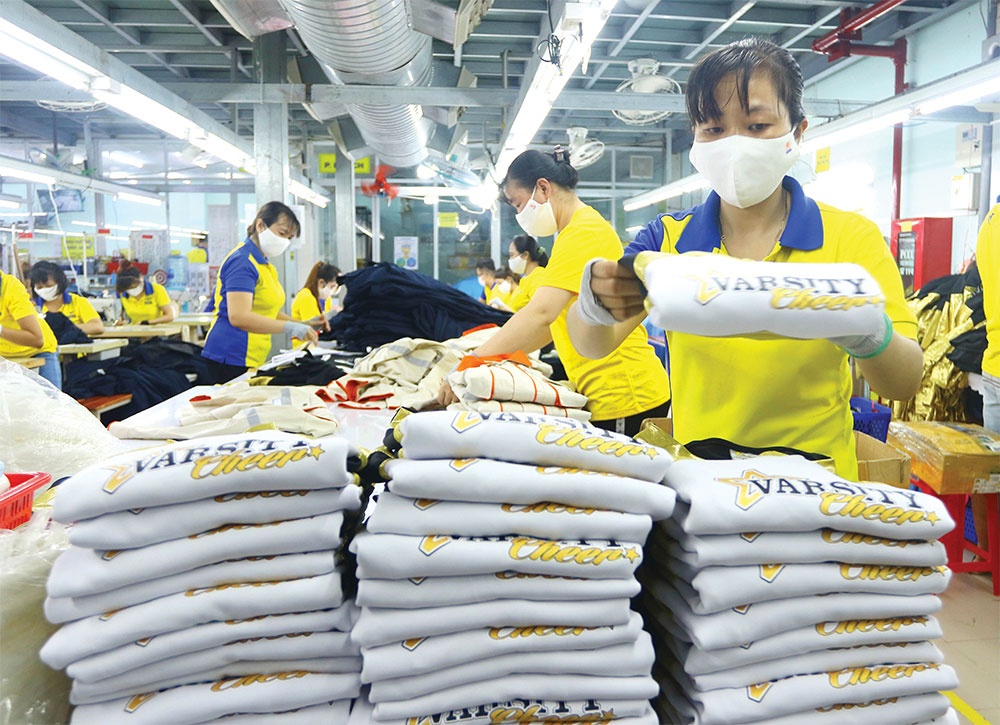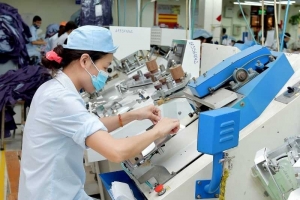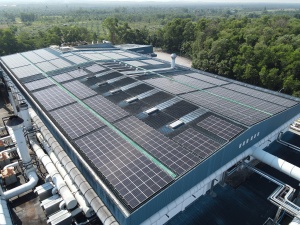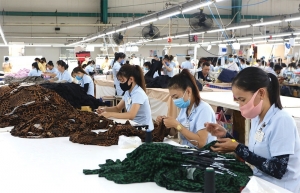Apparel groups begin fine-tuning goals
 |
| Traditional export markets are struggling so garment groups are trying to boost sales in Asia, photo le Toan |
On March 14, the Board of Directors at TNG Investment and Trading JSC approved the company’s 2023 business plans with 11 and 16 per cent hike in the revenue and profit targets compared to the previous year. TNG envisaged counting $326 million in full-year revenue and $14.65 million in profit target this year.
However, on the threshold of TNG’s general shareholders’ meeting slated for April 24, a TNG executive told VIR that the company has since scaled down the business plans to just $295.6 million in revenue and $13 million in profit, almost on a par to last year’s level.
The TNG leader expects the company could still manage business growth in the first half of the year. However, in Q3, its revenue and profit figures may diminish as businesses across the globe are expected to discharge a huge amount of inventory, casting pressure on the export price and revenue growth of the company.
Q4’s business picture is also unpredictable, as the order situation is seasonable and the Chinese market remains a puzzle. The global demand could swell 10 per cent once China fully opens its market.
With a less buoyant export market, Garment 10 Corporation (Garco 10) has set forth to reach $43.47 million in revenue and $4.78 million in pre-tax profit in 2023, down 10 and 26.7 per cent on-year, respectively.
“The conflict between Russia and Ukraine still lingers, casting bad influence on the global economic and political standing, driving up fuel price and that of many materials serving industrial production. Disruptions have also pushed up logistics costs, hampering the rebound pace of economies around the world,” said a Garco 10 leader, citing that the situation casts a shadow on the company’s order picture.
Meanwhile, at Thanh Cong Textile and Garment Investment Trading (TCM), a sluggish export market has reflected on the company’s performance in the first two months of this year.
Accordingly, TCM counted $21 million in revenue during the period, equal to 74 per cent of last year’s figure in the similar period, and its pre-tax profit came to $1.17 million, equal to 70 per cent of that in the same period last year.
TCM’s export structure shows the company taking efforts to boost sales in the Asian market when its traditional export markets, the EU and US, struggle with high inflation and an economic slump.
In the first two months of 2023, the company’s export value to Asian countries accounted for 75 per cent of total export value, in which the South Korean market covered 29 per cent and Japan over 24 per cent, almost equal to the US market at 24.7 per cent. The EU market just made up 3.8 per cent, and exports to the UK made up 3.5 per cent.
The TCM leader assumed that sustainable development is the way to go for Vietnam’s textile sector, and apparel items must not do harm to the environment.
The company’s research and development centre has been operating as a miniature garment and textile model, providing about 8 per cent of the company’s total revenue currently.
Meanwhile, the latest March 2023 Purchasing Managers’ Index report from market researchers S&P Global exhibited a sharp fall in the output, order intake volume, and employment in Vietnam’s manufacturing sector on the back of dwindling customer demand.
In which, the total volume of new order placements has been shed for the fourth time in the past five months, and the number of new order placed from overseas has dropped in the last three months.
In this context, textile firms have tried to avail of cost optimisation measures to cope with order shortfalls and lower export prices.
“This year, we will come up with a host of cost-saving measures comprehensively to overcome market difficulties and soaring costs,” said the Garco 10 leader.
In addition, the company also focuses on effectively tapping the domestic market, as general director Than Duc Viet noted that Vietnam, with a huge population, growing per capita income, and rising middle-class provides much potential market for the garment and textile sector.
Meanwhile, a TNG source noted that as demand in its traditional markets of the EU and the US recedes due to high inflation, the company is boosting exports to other markets such as Canada. Fair growth in exports from markets like these has partly offset the shortfall in the US market.
 | Textile and apparel firms struggling amid interest woes Many textile and apparel firms have had to postpone investment and expansion plans in the face of soaring interest rates, high production costs and dwindling order intake. |
 | BayWa r.e. and Icebug race to reduce carbon footprint in the footwear and apparel industry Global renewable energy developer, BayWa r.e., has announced its collaboration with Swedish shoe manufacturer and sustainability pioneer, Icebug, for the Decarbonising Apparel Manufacturing in Vietnam – On-Site Rooftop Solar Group Procurement programme. Initiated by the Clean Energy Investment Accelerator, the Apparel Impact Institute, and the IDH Sustainable Trade Initiative, the pilot was first rolled out in 2021. |
 | Apparel groups under supply chain pressure Vietnam’s textiles, garments, and footwear are compelled to compete on the basis of quality, the environment, and the working conditions of its employees, since low-cost labour and cheap prices are no longer an advantage. |
What the stars mean:
★ Poor ★ ★ Promising ★★★ Good ★★★★ Very good ★★★★★ Exceptional
Related Contents
Latest News
More News
- Top 10 notable events of Vietnam’s industry and trade sector in 2025 (December 19, 2025 | 14:00)
- Tungsten surges to 12-year high as world enters a new 'black gold' race (December 18, 2025 | 17:27)
- Vietnam’s coffee exports set new record despite price pressures (December 18, 2025 | 17:13)
- Garment and textile sector seeks new growth after volatile year (December 18, 2025 | 17:01)
- VinSpeed and Siemens strengthen cooperation for high-speed rail development (December 18, 2025 | 16:53)
- High-tech adoption for TH true MILK (December 18, 2025 | 13:39)
- Takeda supports health resilience amid climate change challenges (December 18, 2025 | 12:39)
- Mondelez Kinh Do - a chapter of purpose-led leadership in Vietnam (December 18, 2025 | 09:44)
- VNPAY services receive the highest-level PCI DSS international security certificates for six consecutive years (December 17, 2025 | 23:47)
- PPL extends its reach into ASEAN (December 17, 2025 | 15:44)

 Tag:
Tag:






















 Mobile Version
Mobile Version